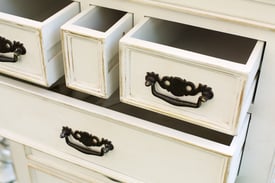How to Add an Antique Look to Your Furniture

 They say, what’s old can be new again, but the reverse is true, too. If you gravitate to antique furniture, you’re going to be pleasantly surprised by how simple it is to make even a new piece of furniture look worn and broken in.
They say, what’s old can be new again, but the reverse is true, too. If you gravitate to antique furniture, you’re going to be pleasantly surprised by how simple it is to make even a new piece of furniture look worn and broken in.
The technique is known among painting professionals as “distressing,” but don’t read too much into the term itself. In this case, it means the furniture – not its owner – has sustained some wear and tear.
If you’ve never distressed furniture before, you might wish to start with a small, manageable piece and then gradually ease your way into larger ones as you gain confidence. If you can find a picture of an antique piece you admire; keep it by your side so you can replicate the look you’re trying to achieve.
Let the distressing begin
- Do some “damage” to the piece to mimic the worn nature of an antique. You can use many tools to instantly age a piece of furniture, including sandpaper, a key, a nail, a wire brush and even a hammer. Some people use chains to beat furniture and create dings and dents. Obviously, it’s crucial not to overdo it; otherwise, you could damage the furniture beyond repair. In addition to wielding a light touch, remember to create distress in such a way it looks random – and real – rather than plan and contrived.
- Sand the piece of furniture lightly if you plan to retain the current paint color or finish. Focus on areas where you wish to show some distress. If you’re not using a picture as a guide, focus on areas where hands are most likely to make contact with the furniture – i.e., around edges, drawers and raised areas. If you plan to change the color of the piece, then remove all the paint or stain.
- Wipe the piece with a tack cloth to remove all the dust.
- Paint or stain the piece, if you wish. A little thought goes a long way, especially because you will apply two coats and can capitalize on the opportunity for contrast. For example, a black topcoat looks stunning with a gold coat underneath. But dark colors stand out as a bottom coat, too, especially if you use a dark chocolate brown first and then an ivory topcoat.
- Rub wax on those areas where you’d like the base coat of paint or stain to show through. You can use any type of wax – even the wax from a candle or crayon. Take notes or photograph these waxed areas; you will need to remember where they are generally located.
- Apply the top coat of paint or stain, which won’t stick to the waxed areas.
- Rub steel wool over the areas where you applied wax so the first coat shows through.
- Wipe the furniture with a tack cloth.
- Apply a protective finish, if you wish, such as a water-based acrylic topcoat.
Distressing furniture (and accessories) can be fun and relaxing, but not quite as enjoyable as shopping for new window shades with a window expert from Polar Shades. Schedule a free in-home consultation by calling 702-260-6110 and learn how to frame your newly distressed furniture in creative new ways.
